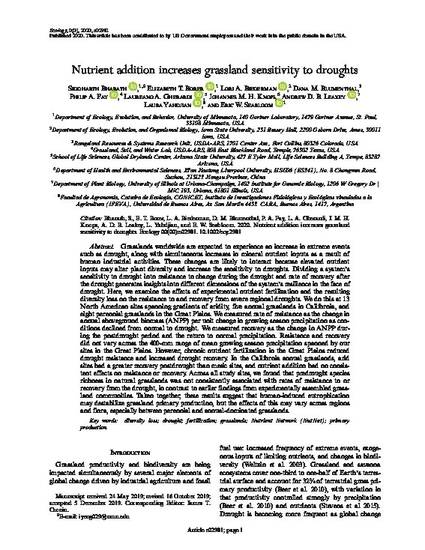
Grasslands worldwide are expected to experience an increase in extreme events such as drought, along with simultaneous increases in mineral nutrient inputs as a result of human industrial activities. These changes are likely to interact because elevated nutrient inputs may alter plant diversity and increase the sensitivity to droughts. Dividing a system’s sensitivity to drought into resistance to change during the drought and rate of recovery after the drought generates insights into different dimensions of the system’s resilience in the face of drought. Here, we examine the effects of experimental nutrient fertilization and the resulting diversity loss on the resistance to and recovery from severe regional droughts. We do this at 13 North American sites spanning gradients of aridity, five annual grasslands in California, and eight perennial grasslands in the Great Plains. We measured rate of resistance as the change in annual aboveground biomass (ANPP) per unit change in growing season precipitation as conditions declined from normal to drought. We measured recovery as the change in ANPP during the postdrought period and the return to normal precipitation. Resistance and recovery did not vary across the 400‐mm range of mean growing season precipitation spanned by our sites in the Great Plains. However, chronic nutrient fertilization in the Great Plains reduced drought resistance and increased drought recovery. In the California annual grasslands, arid sites had a greater recovery postdrought than mesic sites, and nutrient addition had no consistent effects on resistance or recovery. Across all study sites, we found that predrought species richness in natural grasslands was not consistently associated with rates of resistance to or recovery from the drought, in contrast to earlier findings from experimentally assembled grassland communities. Taken together, these results suggest that human‐induced eutrophication may destabilize grassland primary production, but the effects of this may vary across regions and flora, especially between perennial and annual‐dominated grasslands.
Available at: http://works.bepress.com/lori_biederman/27/

This article is published as Bharath, Siddharth, Elizabeth T. Borer, Lori A. Biederman, Dana M. Blumenthal, Philip A. Fay, Laureano A. Gherardi, Johannes MH Knops, Andrew DB Leakey, Laura Yahdjian, and Eric W. Seabloom. "Nutrient addition increases grassland sensitivity to droughts." Ecology (2020). doi: 10.1002/ecy.2981.